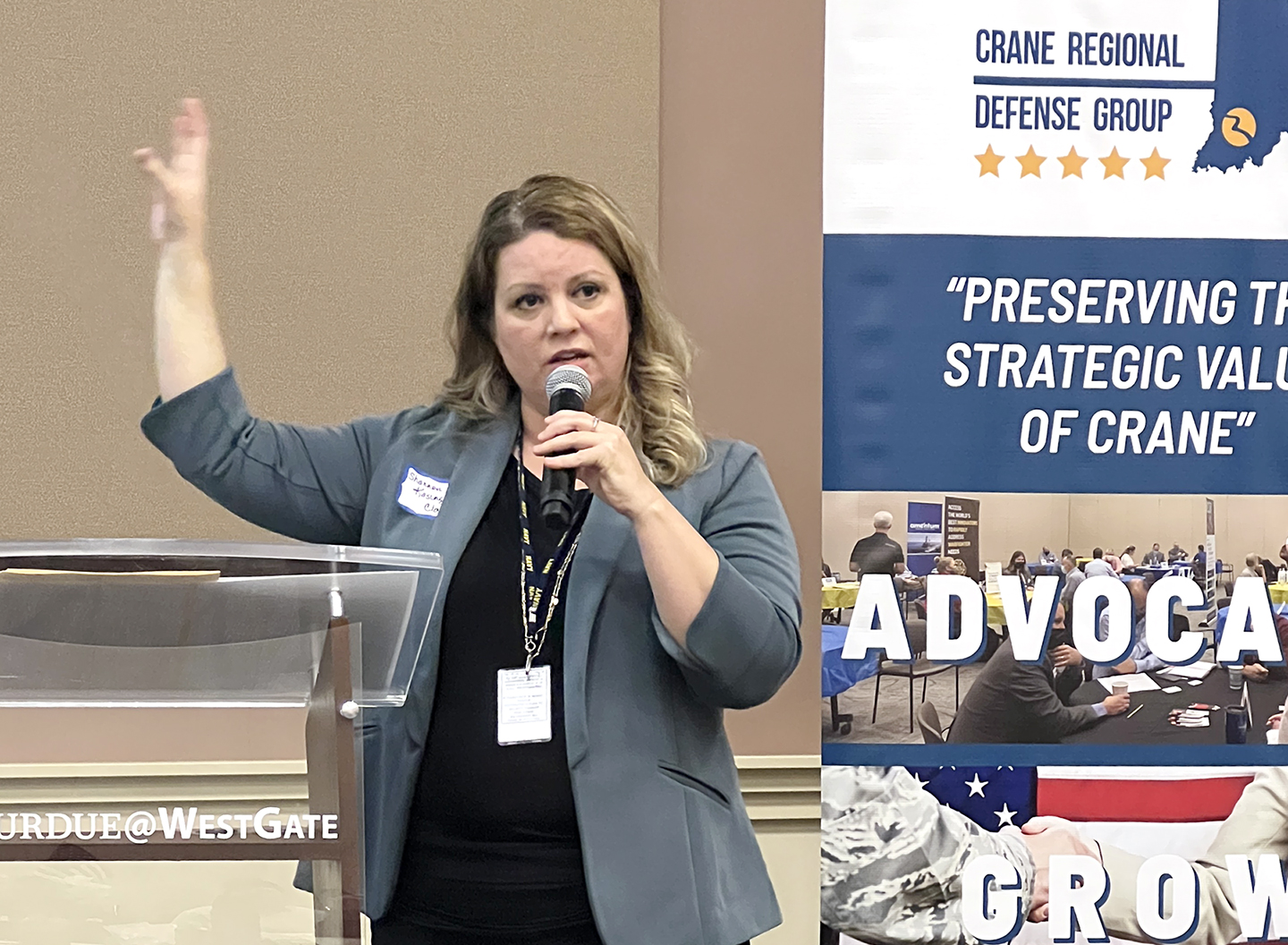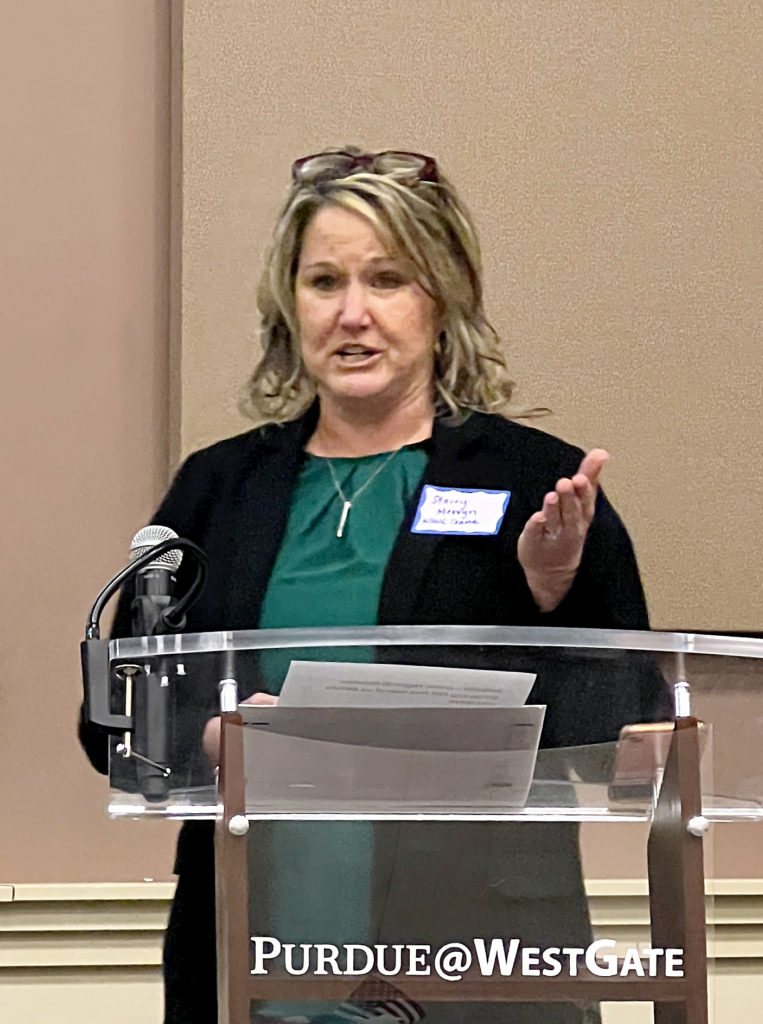By Miles Flynn | Southern Indiana Business Report
ODON — Shannon Kasinger Clark, chief strategist for expeditionary warfare at NSWC Crane, and Stacey Mervyn, chief strategist for electronic warfare with the organization, were the featured speakers Feb. 16 for the third installment of the Crane Regional Defense Group Key Leaders Series at WestGate Academy. Crane Regional Defense Group, a citizen-led sub-committee of the White River Military Alliance, was established in 2020 with the goal of connecting local communities and businesses with Crane as part of a grassroots vehicle for advocacy and education. Its quarterly Key Leaders luncheons have been a part of its efforts now since August.
The theme of both speakers’ talks is that while Crane is a powerful innovation engine supporting America’s warfighters, overall success depends on partnerships outside the base’s perimeter. Kasinger Clark and Mervyn shared details on their work and provided examples of how expertise available outside the base is critically important. “It’s definitely a team sport,” Mervyn said. “We can’t do it alone.”
Kasinger Clark earned a bachelor’s in electrical engineering in 2004 and began working at Crane in power and energy that same year. She took on several new assignments during her time at Crane and went on to earn a master’s in public affairs in 2018. She started working in her current role at Crane the following year.
The expeditionary department is the largest on base now and has a presence there of more than $800 million, she noted. The mission area isn’t limited to one platform or one domain, and the focus of the work is integrating system-on-system setups to shorten the “kill chain” — the military term that defines the structure of an attack, from identifying a target through its destruction.
Part of the shortening of that decision-making process is the development and exploitation of new technologies, Kasinger Clark explained, and the department is accelerating those processes through strong partnerships with academia. For example, she said work with Purdue University even led to the creation of a new degree program through the school. Crane is currently working with Indiana University on artificial intelligence and machine learning.
Kasinger Clark pointed out those partnerships are made even more powerful by the availability of truly unique resources at Crane, such as its testing ranges for systems including electro-chemical technology, the ability to model new concepts virtually, and a concentration of battery technology for methods of powering everything from missiles to submarines. There are capabilities at Crane that simply aren’t found elsewhere, she told the crowd.
Mervyn earned a bachelor’s in electrical engineering in 1998 and began her career at Crane that same year as a systems engineer in the electro-optics technology division. Mervyn has held several positions at Crane since then and earned a master’s in engineering management in 2003 and a master’s in public affairs in 2009. She assumed her current role in 2019.
She told attendees Crane is a recognized center of excellence in electronic warfare, and she explained the major areas of focus include surveillance to provide the intelligence needed to make decisions, communication, and also technology to use energy to draw threats away from warfighters on the land, sea and air.
A well-known, recent example of the latter area, she said, is the CREW system to combat the improvised explosive devices used to target military convoys. She said the technology puts a “protective bubble” around the vehicles. A rather new area of concern, Mervyn said, is countering the threat of enemies using commercial technology easily available now through drones.
Artificial intelligence and machine learning are being incorporated into electronic warfare. Focus areas there include using the technology to expedite decisions and also coming up with strategies and techniques to trick the enemy’s systems.
Among the skillsets most in demand, according to both speakers, are cyber security, communication, artificial intelligence and machine learning, logistics, data analytics, quantum science, RF and electrical engineering, as well as fabrication. They also said businesses looking for ways to work with Crane are encouraged to contact Matt Burkett, NSWC Crane’s deputy director for small business. He can be reached at matt.burkett@navy.mil or 812-854-1542.
Crane Regional Defense Group’s growth, next events
Kent Parisien, chairman of the board of Crane Regional Defense Group, said the organization continues to grow and attract new businesses and organizations from neighboring communities. “We’re over half way to our goal of 40 members by the end of 2022,” he said.
The next Key Leaders events are on the schedule for May 20, Aug. 17 and Nov. 10. In addition, the organization is also working on hosting a second Connect to Crane event on Oct. 12.




